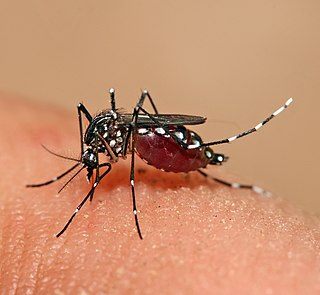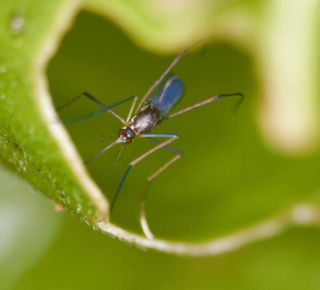
Aedes is a genus of mosquitoes originally found in tropical and subtropical zones, but now found on all continents except Antarctica. Some species have been spread by human activity: Aedes albopictus, a particularly invasive species, was spread to the Americas, including the United States, in the 1980s, by the used-tire trade.

Toxorhynchites, also called elephant mosquito or mosquito eater, is a genus of diurnal and often relatively colorful mosquitoes, found worldwide between about 35° north and 35° south. Most species occur in forests. It includes the largest known species of mosquito, at up to 18 mm (0.71 in) in length and 24 mm (0.94 in) in wingspan. It is among the many kinds of mosquito that do not consume blood. The adults subsist on carbohydrate-rich materials, such as honeydew, or saps and juices from damaged plants, refuse, fruit, and nectar.
Stegomyia is a large subgenus of the mosquito genus Aedes with 131 species classified in six species groups, two groups of which are further divided into subgroups.
Ochlerotatus is a genus of mosquito. Until 2000, it was ranked as a subgenus of Aedes, but after Reinert's work, the clade was upgraded to the level of a genus. This change has resulted in the renaming of many subgenus species, and many aedini-related taxa are undergoing taxonomic revisions. Some authors are still using traditional taxonomic names in their publications.
Haemagogus is a genus of mosquitoes in the dipteran family Culicidae. They mainly occur in Central America and northern South America, although some species inhabit forested areas of Brazil, and range as far as northern Argentina. In the Rio Grande Do Sul area of Brazil, one species, H. leucocelaenus, has been found carrying yellow fever virus. Several species have a distinct metallic sheen.

Anopheles is a genus of mosquitoes (Culicidae). Of about 484 recognised species, over 100 can transmit human malaria, but only 30–40 commonly transmit parasites of the genus Plasmodium that cause malaria, which affects humans in endemic areas. Anopheles gambiae is one of the best known, because of its predominant role in the transmission of the deadly species Plasmodium falciparum.

Mansonia mosquitoes are big, black or brown mosquitoes with sparkling on their wings and legs. They breed in ponds and lakes containing certain aquatic plants, especially the floating type like Pistia stratiotes and water hyacinth. The eggs are laid in star-shaped clusters on the undersurface of leaves of these plants. The larvae and pupae are found attached to the rootlets of these plants by their siphon tubes. They obtain their air supply from these rootlets. When about to become adult, these pupae come to the surface of water and the fully formed adults emerge and escape. The control of Mansonia mosquitoes is easy by removal or destruction of the aquatic host plants by herbicides.
Uranotaenia is a subgenus of the mosquito genus Uranotaenia with 121 species:

Coquillettidia is a mosquito genus erected by entomologist Harrison Gray Dyar Jr. in 1904 based primarily on unique features of its "peculiar" male genitalia. The specific epithet honors Dyar's colleague Daniel William Coquillett.
Lutzia is a genus of mosquitos. First described in 1903 by Frederick Vincent Theobald, it includes species whose larval stages exhibit predatory behavior. The type species is Lutzia bigoti.
The subgenus Kerteszia are Neotropical anopheline mosquitoes originally described in 1905 by Frederick V. Theobald as genus Kertészia with Kertészia boliviensis as the type species.

Sabethes or Canopy Mosquito are primarily an arboreal genus, breeding in plant cavities. The type species is Sabethes locuples, first described by Jean-Baptiste Robineau-Desvoidy in 1827.

Wyeomyia is a genus of mosquitoes first described in 1901 by Frederick Vincent Theobald. The genus's 140 species can be difficult to characterize because of their diversity and the need for additional taxonomic work to further delineate them. Adults resemble genus Limatus and Sabethes mosquitoes more closely than other genera in the New World tribe Sabethini, but differ by their scutal scales ranging in color from a relatively dull bronzy with a slight metallic sheen in most species, to a metallic gold. There are other distinguishing characters as well.
Orthopodomyia is a genus of mosquitoes in the family Culicidae. There are at least 40 described species in Orthopodomyia.
Dixella is a genus of meniscus midges in the family Dixidae. There are more than 70 described species in Dixella.
Tripteroides is a genus of mosquitoes belonging to the family Culicidae. It is a large and complex assemblage of 122 species and 5 subgenera. Species are distributed from India to Japan, and south to Australia including the islands of southeast Asia and the South Pacific. The species comprising the genus are highly diverse, and the relationships among Tripteroides and Trichoproposon species remain unresolved as many characters overlap. The taxonomic status of this genus urgently needs revision to better understand the relationships among the species and to improve the classification of the genus.






